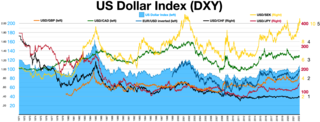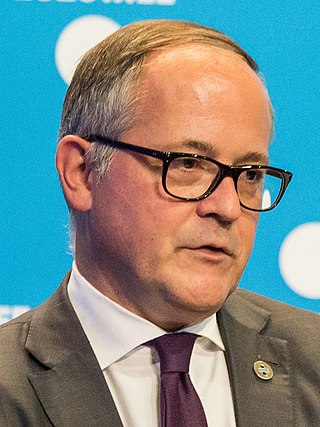
The global financial system is the worldwide framework of legal agreements, institutions, and both formal and informal economic action that together facilitate international flows of financial capital for purposes of investment and trade financing. Since emerging in the late 19th century during the first modern wave of economic globalization, its evolution is marked by the establishment of central banks, multilateral treaties, and intergovernmental organizations aimed at improving the transparency, regulation, and effectiveness of international markets. In the late 1800s, world migration and communication technology facilitated unprecedented growth in international trade and investment. At the onset of World War I, trade contracted as foreign exchange markets became paralyzed by money market illiquidity. Countries sought to defend against external shocks with protectionist policies and trade virtually halted by 1933, worsening the effects of the global Great Depression until a series of reciprocal trade agreements slowly reduced tariffs worldwide. Efforts to revamp the international monetary system after World War II improved exchange rate stability, fostering record growth in global finance.

The foreign exchange market is a global decentralized or over-the-counter (OTC) market for the trading of currencies. This market determines foreign exchange rates for every currency. It includes all aspects of buying, selling and exchanging currencies at current or determined prices. In terms of trading volume, it is by far the largest market in the world, followed by the credit market.
A foreign exchange spot transaction, also known as FX spot, is an agreement between two parties to buy one currency against selling another currency at an agreed price for settlement on the spot date. The exchange rate at which the transaction is done is called the spot exchange rate. As of 2010, the average daily turnover of global FX spot transactions reached nearly US$1.5 trillion, counting 37.4% of all foreign exchange transactions. FX spot transactions increased by 38% to US$2.0 trillion from April 2010 to April 2013.
Delivery versus payment or DvP is a common form of settlement for securities. The process involves the simultaneous delivery of all documents necessary to give effect to a transfer of securities in exchange for the receipt of the stipulated payment amount. Alternatively, it may involve transfers of two securities in such a way as to ensure that delivery of one security occurs if and only if the corresponding delivery of the other security occurs.

Wire transfer, bank transfer, or credit transfer, is a method of electronic funds transfer from one person or entity to another. A wire transfer can be made from one bank account to another bank account, or through a transfer of cash at a cash office.
The Depository Trust & Clearing Corporation (DTCC) is an American post-trade financial services company providing clearing and settlement services to the financial markets. It performs the exchange of securities on behalf of buyers and sellers and functions as a central securities depository by providing central custody of securities.
Settlement risk, also known as delivery risk or counterparty risk, is the risk that a counterparty fails to deliver a security or its value in cash as per agreement when the security was traded after the other counterparty or counterparties have already delivered security or cash value as per the trade agreement. The term covers factors incidental to the settlement process which may suspend or prevent a trade from completing, even though the parties themselves are in agreement, are acting in good faith, and otherwise competent to perform.
A payment system is any system used to settle financial transactions through the transfer of monetary value. This includes the institutions, payment instruments such as payment cards, people, rules, procedures, standards, and technologies that make its exchange possible. A payment system is an operational network regulated by laws and standards, and links bank accounts and provides for monetary exchange using bank deposits. Some payment systems also include credit mechanisms, which are essentially a different aspect of payment.

Herstatt Bank was a privately owned bank in the German city of Cologne. It went bankrupt on 26 June 1974, an event widely referred to as the Herstatt crisis. Herstatt's failure specifically highlighted the importance of settlement risk in foreign-exchange markets, which became correspondingly known as Herstatt risk.
Foreign exchange risk is a financial risk that exists when a financial transaction is denominated in a currency other than the domestic currency of the company. The exchange risk arises when there is a risk of an unfavourable change in exchange rate between the domestic currency and the denominated currency before the date when the transaction is completed.

The Asian Clearing Union (ACU) was established on December 9, 1974, at the initiative of the United Nations Economic and Social Commission for Asia and the Pacific (ESCAP). The primary objective of ACU, at the time of its establishment, was to secure regional co-operation regarding the clearing of eligible monetary transactions among the members of the Union to provide a system for clearing payments among the member countries on a multilateral basis.
In law, set-off or netting is a legal technique applied between persons or businesses with mutual rights and liabilities, replacing gross positions with net positions. It permits the rights to be used to discharge the liabilities where cross claims exist between a plaintiff and a respondent, the result being that the gross claims of mutual debt produce a single net claim. The net claim is known as a net position. In other words, a set-off is the right of a debtor to balance mutual debts with a creditor.
The Kazakhstan Stock Exchange is a stock exchange located in Almaty, Kazakhstan. The exchange was founded in 1993.
Systemically important payment systems (SIPS) are payment systems which have the characteristic that a failure of these systems could potentially endanger the operation of the whole economy. In general, these are the major payment clearing systems or real-time gross settlement systems of individual countries, but in the case of Europe, there are certain pan-European payment systems. TARGET2 is a pan-European SIPS dealing with major inter-bank payments. STEP2, operated by the Euro Banking Association, is a major pan-European clearing system for retail payments which has the potential to become a SIPS.
A net settlement is a payment system used for inter-bank transactions. It is the process by which banks calculate the collective total of all transactions through designated times each day.

The Moscow Exchange is the largest exchange in Russia, operating trading markets in equities, bonds, derivatives, the foreign exchange market, money markets, and precious metals. The Moscow Exchange also operates Russia's central securities depository, the National Settlement Depository (NSD), and the country's largest clearing service provider, the National Clearing Centre. The exchange was formed in 2011 in a merger of the Moscow Interbank Currency Exchange and the Russian Trading System.

Benoît Georges Cœuré is a French economist who has been serving as President of the Autorité de la concurence since 2022. He previously served as a member of the Executive Board of the European Central Bank from 2012 to 2019.
The forex scandal is a 2013 financial scandal that involves the revelation, and subsequent investigation, that banks colluded for at least a decade to manipulate exchange rates on the forex market for their own financial gain. Market regulators in Asia, Switzerland, the United Kingdom, and the United States began to investigate the $4.7 trillion per day foreign exchange market (forex) after Bloomberg News reported in June 2013 that currency dealers said they had been front-running client orders and rigging the foreign exchange benchmark WM/Reuters rates by colluding with counterparts and pushing through trades before and during the 60-second windows when the benchmark rates are set. The behavior occurred daily in the spot foreign-exchange market and went on for at least a decade according to currency traders.

Midpoint is a UK headquartered, Toronto and Frankfurt listed company providing international payments and peer-to-peer foreign exchange services to individual and corporate customers. Midpoint is the world’s first dedicated peer-to-peer international foreign currency matching platform. The company's patented matching technology was the first application of peer-to-peer concept in the spot forex market.
David Puth is an American financial services executive who has held senior positions at several financial service companies. He was chief executive officer of USD Coin (USDC) standards body, Centre from 2020 until Centre was absorbed by Circle. Between 1988 and 2007, he worked at J.P. Morgan where he served in a variety of senior global leadership roles.









